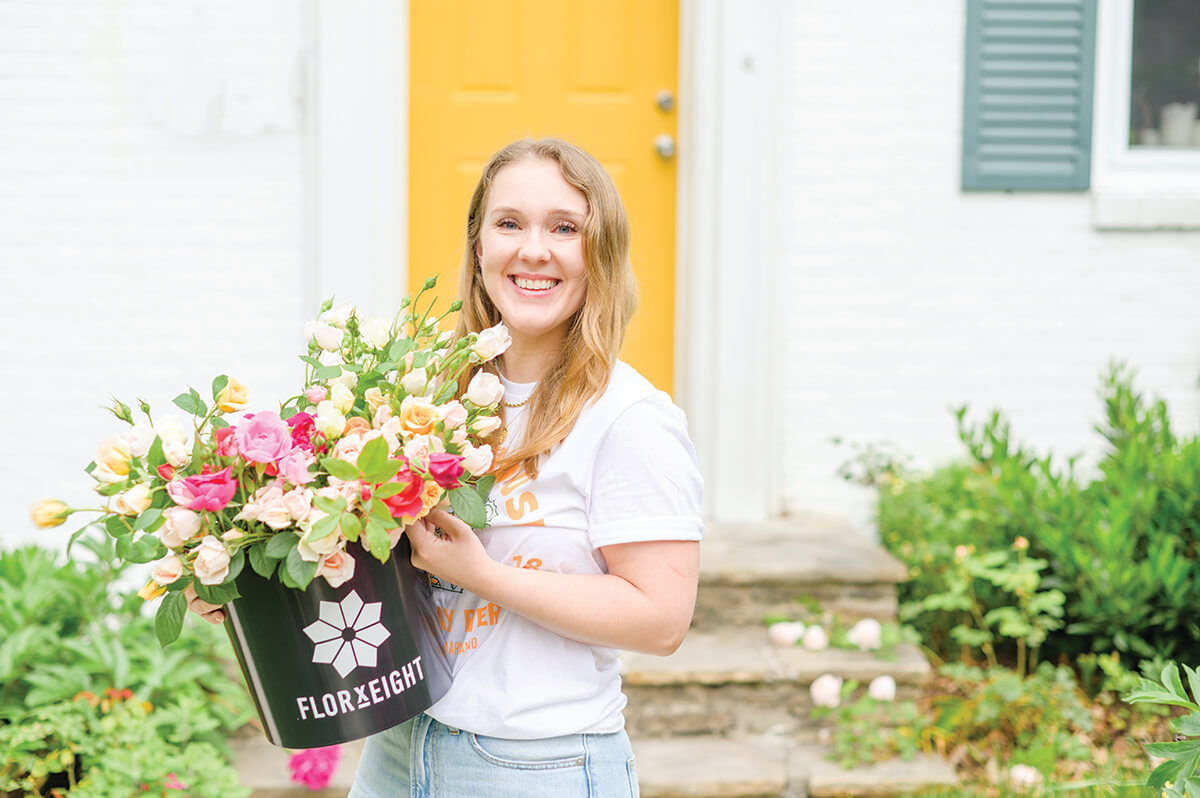Home & Living
Florxeight Wants to Put Maryland on the Map for Rose-Growing
Lauren Uhlig’s blossoming rose business is nothing short of miraculous.

When Lauren Uhlig moved from an apartment to a home in northeast Baltimore’s Hamilton Hills in 2016, she was excited about the four-by-eight vegetable bed in the backyard. Although she works as an architect, Uhlig was inspired to explore the local cut flower movement and, on a whim, she decided to try her hand at growing some roses. When she told people about her blooming aspirations, they all said the same thing: good luck.
Roses are notoriously difficult to grow in this area due to heat, humidity, and deer. But Uhlig, 31, was undeterred. She bought five rose bushes in 2019 just to see if she could keep them alive and now she has several hundred—and many more four-by-eight flower beds in the backyard.
“I still remember my first rose,” she says. “I was so proud of myself. I had grown a rose and it had bloomed and it was magical. And I haven’t stopped since.
“I had no background in gardening, no background in roses, it was just something I fell into, and seem to have a knack for,” she continues.
She had such a knack, she decided to turn it into a business. In honor of that first garden bed, Uhlig started Florxeight (pronounced floor-by-eight) in 2019 and now sells cut roses directly to local florists.
Despite their high-maintenance reputation, Uhlig says roses are one of the world’s oldest flowers. Fossil records indicate the existence of roses 30 million years ago. So, while they may be persnickety to grow, “at their core, they’re scrappy,” she says.
Uhlig plants English style heirloom garden roses. When the forsythia starts to bloom, usually in March, she knows it is time to wake up her garden. She prunes out anything diseased, damaged, or dead, as well as any spindly canes less than the thickness of a pencil. (She says one of the biggest mistakes gardeners make is not pruning their roses enough.)
This is also when she starts to fertilize, using a recipe of natural-based products she mixes up herself. She fertilizes “weakly weekly”—in small amounts on a weekly basis—throughout the growing season and until roughly six weeks before the first frost.
“It’s like the diet of a performance athlete, they need to consume enough nutrients for their energy output,” she explains, “but it’s not necessary for anyone who just wants beautiful garden roses.”
Throughout the spring and in fall—she takes a break during the high heat of summer when the demand is less—Uhlig’s roses produce lush, multi-petaled florals. They are the definition of romance, the type of roses Willian Shakespeare had in mind when he wrote “a rose by any other name would smell as sweet.”
“My roses are delicate, with a shorter vase life but with the most wonderful smell,” says Uhlig.
In short, these are nothing like the stiff, tight-budded roses on offer at the local grocery store. Those buds are Uhlig’s prime competitors. According to the USDA, the U.S. imported more than $800-million worth of roses in 2022, almost all from Central and South America, and imports have led to a 95-percent decline in domestic rose production.
Those roses generally have no scent but have long, sturdy stems and the unblemished blooms florists require. Of course, perfection comes at a price; imported roses are created using a tremendous amount of pesticide, often unscrupulously applied, leaving communities ravaged by the impacts of pollution. And the carbon cost to get them to U.S. markets is significant.
It’s one of many reasons Ellen Frost, owner of Local Color Flowers, says she always joked that she was the only floral designer who didn’t work with roses. Her business, which helped pioneer the local flower movement in Maryland, only uses stems grown within 100 miles of Baltimore. And there were no roses in that radius. So, when she heard Uhlig was going to try to grow them, she was intrigued, excited, and, of course, a little skeptical.
When Uhlig produced her first bloom, she proudly took it directly to Frost. “We told her, ‘Everything you produce, we’ll buy,’” Frost recalls. She says the blooms are beloved by customers who have long had an appetite for local roses.
Frost says that while the flowers are “stunning,” it is their scent you notice first, especially if one is accustomed to scentless imported roses.
“They aren’t just fragrant, but every variety has a different fragrance,” she explains. “And fragrance is so important because so much of what we love about flowers is attached to scent memory; roses can take you back to your wedding day or to your grandmother’s yard or a special garden you visited.”
For the best results growing roses at home, Uhlig says to look for varieties that are disease-resistant and known to do well in this area. She picks up lots of good intel on varieties that excel in climates similar to Baltimore’s from rose web forums. She uses integrated pest management practices too, attracting beneficial insects and applying non-chemical sprays to combat most diseases and pests. To help others who want to accept the challenge of growing their own roses, Uhlig is also running an online course.
Frost says it cannot be overstated just how remarkable it is that Uhlig is having success in her endeavor. “In the national scheme of flower growing, it is very exciting to have this coming out of our city,” says Frost.
If Uhlig has her way, she’s going to put Maryland on the map for rose growing. She admits it is a far-fetched dream, but if her wonderous little northeast Baltimore backyard is a litmus test, she may just make that dream a reality.